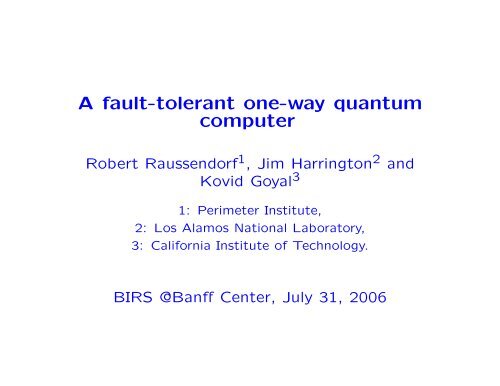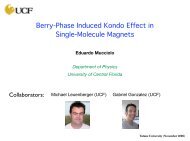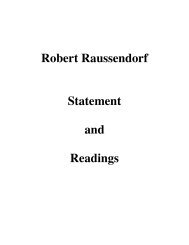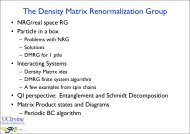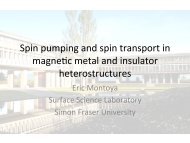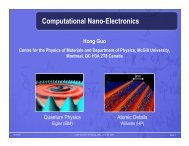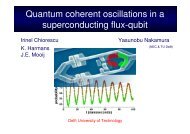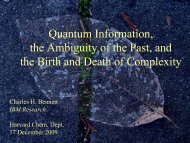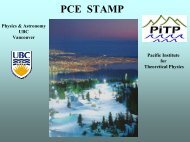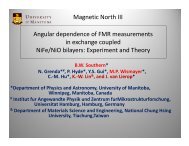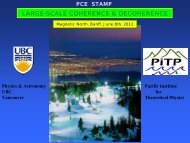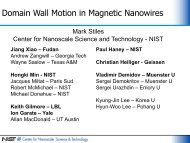A fault-tolerant one-way quantum computer - PiTP
A fault-tolerant one-way quantum computer - PiTP
A fault-tolerant one-way quantum computer - PiTP
Create successful ePaper yourself
Turn your PDF publications into a flip-book with our unique Google optimized e-Paper software.
A <strong>fault</strong>-<strong>tolerant</strong> <strong>one</strong>-<strong>way</strong> <strong>quantum</strong><strong>computer</strong>Robert Raussendorf 1 , Jim Harrington 2 andKovid Goyal 31: Perimeter Institute,2: Los Alamos National Laboratory,3: California Institute of Technology.BIRS @Banff Center, July 31, 2006
Talk outlinePart I: One-<strong>way</strong> <strong>quantum</strong> <strong>computer</strong> (QC C ) and cluster statesWhat is the <strong>one</strong>-<strong>way</strong> <strong>quantum</strong> <strong>computer</strong>?Part II: Fault-toleranceWhich methods are used? What is the threshold?3D cluster state =<strong>fault</strong>-<strong>tolerant</strong> substrateLogic from non-trivialboundary conditions
Part I:The <strong>one</strong>-<strong>way</strong> <strong>quantum</strong> <strong>computer</strong> and cluster states
The <strong>one</strong>-<strong>way</strong> <strong>quantum</strong> <strong>computer</strong>measurement of Z (⊙), X (↑), cos α X + sin α Y (↗)• Universal computational resource: cluster state.• Information written onto the cluster, processed andread out by <strong>one</strong>-qubit measurements only.
Cluster states - creation1. Prepare product state ⊗ a∈Clattice C.|0〉 a + |1〉 a√2on d-dimensional qubit2. Apply the Ising interaction for a fixed time T (conditionalphase of π accumulated).
Cluster states - simple examples|ψ〉 2 = |0〉 1 |+〉 2 + |1〉 1 |−〉 2Bell state|ψ〉 3 = |+〉 1 |0〉 2 |+〉 3 + |−〉 1 |1〉 2 |−〉 3GHZ-state|ψ〉 4 = |0〉 1 |+〉 2 |0〉 3 |+〉 4 + |0〉 1 |−〉 2 |1〉 3 |−〉 4 ++ |1〉 1 |−〉 2 |0〉 3 |+〉 4 + |1〉 1 |+〉 2 |1〉 3 |−〉 4Number of terms exp<strong>one</strong>ntial in number of qubits!
Cluster states - definitionA cluster state |φ〉 C on a cluster C is the single common eigenstateof the stabilizer operatorsK a = X a⊗b∈N(a)Z b , ∀a ∈ C, (1)where b ∈ N(a) if a,b are spatial next neighbors in C.Z-measurementZ-Rule:removes qubitfrom the cluster
Cluster states - experimentCold atoms in opticallatticesCoherent interaction amongneighboring atomsGreiner, Mandel, Esslinger, Hänsch, and Bloch, Nature 415, 39-44 (2002),Greiner, Mandel, Hänsch and Bloch, Nature, 419, 51-54 (2002).
Part II:Fault-tolerance
The threshold theoremTheorem ∗ : Assume a suitable noise model for a universal <strong>quantum</strong><strong>computer</strong>. If the noise per elementary operation is belowa constant non-zero threshold ɛ then arbitrarily long <strong>quantum</strong>computations can be performed with arbitrary accuracy atsmall operational overhead.What is a suitablenoise model?Standard:Indepedent probabilisticerrorsWhat is the value ofɛ?ɛ = 10 −10 ..10 −2What is a smalloverhead?Polylogarithmic.S −→ S log γ SGeneralized Improve threshold! Reduce overhead!*: Aharonov & Ben-Or (1996), Kitaev (1997), Knill & Laflamme & Zurek(1998), Aliferis & Gottesman & Preskill (2005)
Known threshold valuesno constraint[1][2][3][4]!0.03, est.101010-3-4-5, est., est., bd.3Dgeometric constraint[5]*10 -3 , est.2D[6] 10 -5 , est.1D[7] 10 -8 , est.!: 10 14 bare gates for 1000 encoded gates [Knill, (2004)][1] Knill, (2005); [2] Zalka (1999); [3] Dawson & Nielsen (2005); [4] Aliferis& Gottesman & Preskill (2005), [5] Raussendorf & Harrington & Goyal,quant-ph/0510135; [6] Cross (unpublished), [7] Aharonov & Ben-Or (1999)
Fault-<strong>tolerant</strong> <strong>one</strong>-<strong>way</strong> QCMain idea: Replace 2D cluster state by 3D cluster state!3D cluster state = <strong>fault</strong><strong>tolerant</strong>substrateLogic from non-trivialboundary conditions
Macroscopic viewThree cluster regions:V (Vacuum), D (Defect) and S (Singular qubits).Qubits q ∈ V :Qubits q ∈ D:Qubits q ∈ S:local X-measurements,local Z-measurements,local measurements of X±Y√2.
Microscopic viewcluster edges2z1001 2xelementary cell of Lqubit location: (even, odd, odd) - face of L,qubit location: (odd, odd, even) - edge of L,syndrome location: (odd, odd, odd) - cube of L,syndrome location: (even, even, even) - site of L.
Lattice duality L ←→ LTranslation by vector (1, 1, 1) T :• Cluster C invariant,• L (primal) −→ L (dual).face of L − edge of L,edge of L − face of L,site of L − cube of L,cube of L − site of L,(2)• Many objects in this scheme exist as ‘primal’ and ‘dual’.
Key to scheme
Surface codesplaquettestabilizerOne qubit located on every edgesite stabilizerZ =ZZ ZZ ZXX XXZZZZZXXXXXXXZ XXZZsyndrome at endpointharmlesserrorequivalentharmfulerrors=X• Errors are represented by chains.• Homologically equivalent chains correspond to physicallyequivalent errors.• Harmfull errors stretch across the entire lattice (rare events).A. Kitaev,quant-ph/9707021 (1997).
QC C : topological error correction in Velementary cellharmful errorcluster• Errors are represented by chains.• Homologically equivalent chains correspond to physicallyequivalent errors.• Harmfull errors stretch across the entire lattice.-> Leads to Random plaquette Z 2 -gauge model (RPGM) [1].[1] Dennis et al., quant-ph/0110143 (2001).
RPGM: schematic phase diagramMap error correction to statistical mechanics:Tno ECNishimori lineEC3%optimalError correction [1]Minimum weightchain matching [2]p[1] T. Ohno et al., quant-ph/0401101 (2004). [2] E. Dennis et al., quant-ph/0110143(2001); J. Edmonds, Canadian J. Math. 17, 449 (1965).
Error model:• Cluster state created in a 4-step sequence of Λ(Z)-gatesfrom product state ⊗ a∈C |+〉 a .• Error sources:– |+〉-preparation: Perfect preparation followed by 1-qubit partiallydepolarizing noise with probability p P .– Λ(Z)-gates: Perfect gates followed by 2-qubit partially depolarizingnoise with probability p 2 .– Memory: 1-qubit partially depolarizing noise with probability p Sper time step.– Measurement: Perfect measurement preceeded by 1-qubit partiallydepolarizing noise with probability p M .• 3D cluster state created in slices of fixed thickness.• Instant classical processing.
Fault-tolerance threshold in Vp 2,c = 9.6 × 10 −3 , for p P = p S = p M = 0,p c = 5.8 × 10 −3 , for p P = p S = p M = p 2 =: p.(3)
Fault-<strong>tolerant</strong> <strong>quantum</strong> logic
Surface codesrough edgesmooth edgeXZTorusPlane segmentholePlane with 2 holes2 Qubits 1 Qubit1 Qubit• Storage capacity of the code depends upon the topology ofthe code surface.
Surface codesmissing site stabilizerprimal holeXX XXmissing plaquette stabilizerdual holeZZZZ• There are two types of holes: primal and dual.• A pair of same-type holes constitutes a qubit.
Defects for <strong>quantum</strong> logicDefects are the extension of holesin the code plane to the third dimension.
Defects for <strong>quantum</strong> logicA <strong>quantum</strong> circuit is encoded in the <strong>way</strong>primal and dual defects are wound around another.
Quantum gates, Part I
• Displayed <strong>fault</strong>-<strong>tolerant</strong> gates are not universal.• Need <strong>one</strong> non-Clifford element:<strong>fault</strong>-<strong>tolerant</strong> measurement of X±Y √2.Singular Qubits
Quantum gates, Part IIEncoder and decoder for surface code:singularqubitEncoderDecoder
Quantum gates, Part IIA circuit for code-conversion:Reed-MullerencoderCNOTs,|0 , |+ -preps.qubit, encoded withsurface codequbit, encoded withReed-Muller code• Reed-Muller code: Fault-<strong>tolerant</strong> measurement of X±Y √ via 2local measurements of X a±Y √2 aand classical post-processing.-> Fault-<strong>tolerant</strong> universal gate set complete.
Fault-tolerance threshold in S• Topological error correction breaks down near the S-qubits.• Leads to an effective error on S-qubits.• This effective error is local.
Fault-tolerance threshold in SError budget from Reed-Muller concatenation threshold:7615 p 2 + 2 3 p P + 4 3 p M + 4 3 p S < 1105 . (4)Specific parameter choices:p 2,c = 2.9 × 10 −3 , for p P = p S = p M = 0,p c = 1.1 × 10 −3 , for p P = p S = p M = p 2 =: p.(5)The Reed-Muller code sets the overall threshold.
Remark 1 - mapping to 2D• Make “simulated time” real time. Entangle slice-wise.→ 2D qubit lattice suffices.
Remark 2 - HomologyUndetectable errors ∼ = 1-cycles,measured correlations ∼ = 2-cycles.
Summary[quant-ph/0510135]Numbers:• Fault-tolerance threshold of 1.1 × 10 −3 in 3D local architecture.Methods:• Cluster states in three spatial dimensions provide intrinsictopological error correction.


